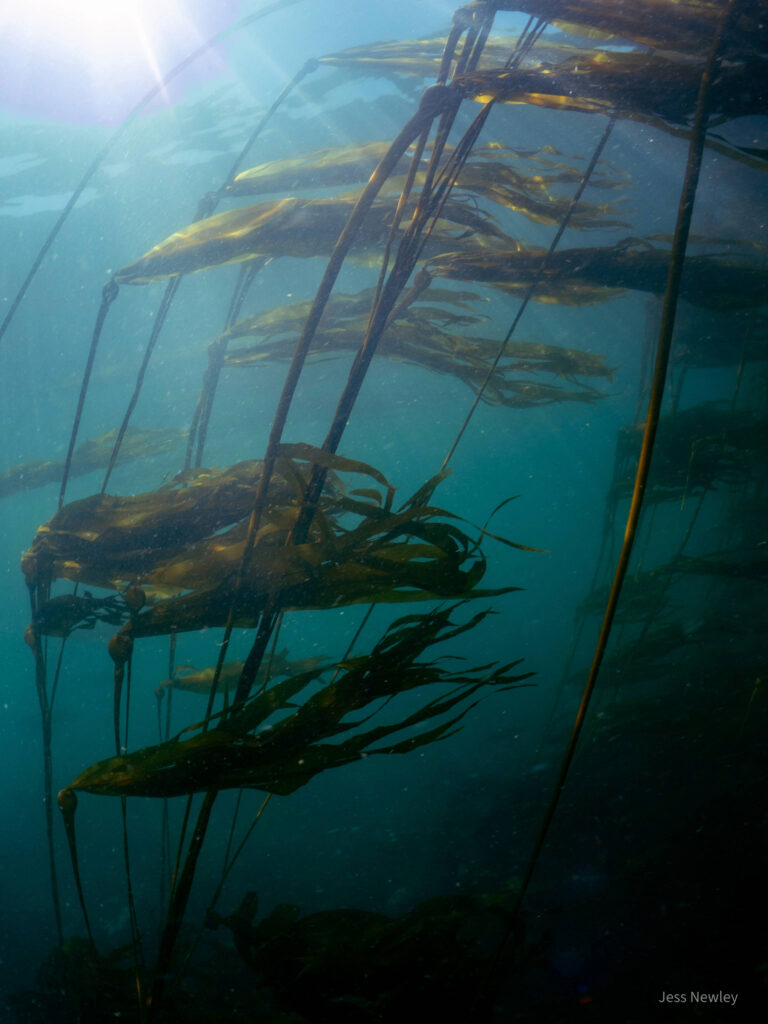You may have glimpsed something strange and beautiful around the San Juans: a pod of orcas twirling through the kelp, wrapping themselves in long golden fronds like playful dancers.
New research from the Center for Whale Research confirms what many Indigenous knowledge holders, islanders, and kayak guides have observed for years—Southern Resident killer whales use bull kelp not just for foraging and play but as a kind of social self-care, rubbing each other’s bodies with the stipe as a way to bond and groom their skin. Their use of bull kelp as a tool is just one more reminder that kelp isn’t just a plant. It’s habitat, a playground, and medicine for this bioregion.
These underwater forests are disappearing, and fast. Bull kelp beds across the Salish Sea are threatened by warming waters, pollution, and vessel traffic. Friends of the San Juans’ countywide mapping effort in 2009 provided the first baseline data on kelp in the area. A decade later, the Samish Indian Nation used that baseline to estimate a 30% decline in bull kelp over just ten years.

Recognizing the urgency, floating kelp (like bull kelp) was officially added as a Vital Sign Indicator in the Puget Sound Action Agenda in 2023, unlocking new resources and regional focus for kelp monitoring, research, and protection.
That momentum has been building locally for years. Friends of the San Juans has long prioritized kelp conservation with foundational studies, defending sensitive shorelines, and protecting miles of bull kelp habitat.
This spring, the tide turned further in bull kelp’s favor.
On April 16, 2025, Governor Ferguson signed legislation officially designating bull kelp as Washington’s state marine forest. The bill also established April 16 as “Bull Kelp Day,” an annual celebration of this vital species that can grow up to ten inches per day and stretch nearly 60 feet below the surface.
And the bill didn’t just pass quietly. It gained momentum thanks in part to youth advocates who showed up to testify, organize, and speak out about their vision for a future where kelp forests still thrive. Their leadership added urgency to the effort and underscored what many of us already believe: restoring bull kelp is essential to the long-term health, resilience, and cultural vitality of the San Juan Islands. And it’s a fight worth taking on.
That growing support was on full display last summer, when former Governor Jay Inslee joined Friends of the San Juans and researchers from UW Friday Harbor Labs for a boat tour through the kelp- and eelgrass-rich waters of the islands. Together, they discussed the urgency of protecting these ecosystems, from preventing oil spills to strengthening shoreline resilience. His presence reaffirmed the power of state-level action paired with local leadership and science. And fun fact: Governor Inslee is now one of Friends’ Green Boater Ambassadors.
More recently, a transformative NOAA climate resilience grant was awarded to Washington State, including a project of the Samish Indian Nation and Friends of the San Juans. This financial assistance, provided by Ecology and the Inflation Reduction Act, will enable us to apply the latest information on kelp and other ecological and cultural protection priorities to build a future where healthy kelp forests can rebound. The Samish Nation’s divers, paddlers, and researchers lead regular surveys of the kelp beds near Cypress and Burrows Islands—while Friends contributes decades of mapping data, research on vessel traffic impacts, and shoreline habitat restoration and policy expertise.
Friends, along with our partners, are also exploring opportunities to understand better how forage fish and juvenile salmon utilize kelp beds for shelter and migration. Also, our interactive shoreline habitat map—designed by Shoreline & Mapping Specialist Katherine Dietzman—allows you to discover where kelp and eelgrass are located across the San Juans. You can explore the interactive map here and watch a video of Katherine guiding you through the map.
Behind every bull kelp bed is a web of life: herring glistening throughout, crab and juvenile salmon darting between fronds, orcas swirling for a social spin. And behind that web of life is a growing network of people and organizations working together to ensure it remains intact—tribal scientists, youth advocates, local researchers, and organizations like Friends of the San Juans.
Let’s use the passage of House Bill 1631 to build on the energy already taking root—anchoring bull kelp at the heart of environmental policy and deepening our shared commitment to restore it. This legislation doesn’t just name a day. It makes bull kelp a part of how we discuss identity, place, and responsibility in Washington. It builds cultural recognition and unites scientists, youth, Tribes, and advocates behind a bold, shared vision for the Salish Sea.
Want to be part of the movement to protect kelp? Here are some ways to help:
- Become a Friends member to support science, advocacy, and restoration work that keeps these underwater forests thriving. Your donation of any amount, or volunteering just four hours, secures a one-year membership.
- Join Friends at a beach walk this summer to learn more about the shoreline habitats that make this region so unique and what you can do to help protect them.
- Sign up for Action Alerts to stay informed and speak up when kelp, shorelines, and marine species need your voice.
